Table of contents
White beans are a variety of the common bean ( Phaseolus vulgaris) and contain lots of fibre and protein.
Use in the kitchen
The kidney-shaped beans are closely related to the red kidney beans. The skin is white to cream-colored.
Raw white beans are poisonous because of the lectin they contain. You must therefore always soak them and then cook or sprout them before you can eat them. You can find out more about this under the link " Phytic acid or phytate and soaking or sprouting ".
As a plant-based protein source, they are an ideal ingredient in hearty soups or stews. They can also be used to make patties, falafel or refried beans. The well-known "baked beans", white beans baked in tomato sauce, are a popular breakfast item in Great Britain. Cooked white beans can also be used in fresh raw salads.
Vegan recipe for Mediterranean salad with white beans
Ingredients (for 4 people): 500 g white beans, 1 red onion, 200 g cherry tomatoes, 1 red bell pepper, 1 cucumber, 10-15 black olives (pitted), 1 tbsp capers, 1 bunch of parsley, 1 bunch of mint. Serve with an oil-free vinaigrette (salad dressing) with walnuts and orange juice.
Preparation: Cook the white beans and let them cool ( link to preparation). Peel the onions and chop finely. Wash the cherry tomatoes, sweet peppers and cucumber and cut the sweet peppers and cucumber into small cubes. Put these in a large bowl together with the white beans. Add the olives and capers. Wash the parsley and mint if necessary, chop finely and mix into the mixture.
Vegan recipes with white beans can be found under the note: " Recipes that have the most of this ingredient ".
| Not only vegans or vegetarians should read this: Vegans often eat unhealthily. Avoidable nutritional errors. |
Purchasing - Storage
Raw white beans can mostly be bought in dried form, some in organic quality. They are available all year round. They can occasionally be bought in large supermarket chains such as Coop, Migros, Spar, Rewe, Edeka or Hofer. Other supermarkets such as Aldi, Denner, Volg, Lidl and Billa rarely stock them. White beans are also available in organic supermarkets such as Denn's Biomarkt or Alnatura or in health food stores. Cooked white beans in cans or jars are more common. Regionally grown beans are in season between April and September. 19
The availability of white beans varies depending on the size of the store, catchment area, etc. If you are interested, click on our recorded food prices for the DA-CH countries (above under the ingredient image). There you will find current prices from various supermarkets and their price development.
Storage tips
Dried white beans can be stored in tightly closed jars or cans, or in the original packaging, in a dry place for one to two years. 3
Ingredients - Nutritional values - Calories
Raw white beans (organic) contain 333 kcal per 100 g. They are very rich in fiber with 15 g/100g. 100 g of beans contain 23 g of protein and 60 g of carbohydrates. The fat content is low at 0.85 g/100g. 1
White beans contain a lot of folate (folic acid) at 388 µg/100g. When cooked, however, the content drops to 102 µg/100g, which still corresponds to 51% of the daily requirement. Cooked kidney beans (130 µg),cooked black beans (149 µg), and cooked lentils (181 µg) have a higher folate content. 1
The protein-rich beans contain all eight essential amino acids. Tryptophan and threonine are abundant, with 0.28 g and 0.98 g per 100 g respectively. This corresponds to 112% and 106% of the daily requirement. However, the content decreases when cooked to 0.10 g and 0.35 g per 100 g respectively. 1
Potassium is also plentiful at 1795 mg/100g. However, this is lost in the water during washing and cooking, which is why cooked white beans only contain around 391 mg/100g. Broad beans also contain plenty of potassium at 1062 mg/100g. Unlike white beans, these can be eaten raw in small quantities. Potassium is also plentiful in cooked soybeans (515 mg), spinach (558 mg) and lamb's lettuce (459 mg). Bananas, which are often cited as a good source of potassium, only contain 358 mg/100g. 1
The trace element manganese is contained in the food at 1.8 mg/100 g. This corresponds to 90% of the daily requirement. Cooked white beans contain 0.52 mg/100 g. Cooked chickpeas (0.99 mg/100 g) and cooked soybeans (0.82 mg/100 g) contain more manganese. 1 Nuts such as pine nuts (8.8 mg/100 g) and hazelnuts (6.2 mg/100 g) contain particularly high levels of manganese.
The complete ingredients of white beans, the coverage of the daily requirement and comparison values with other ingredients can be found in our nutrient tables. In the article Nutrients explained you will get a detailed insight into the topic.
Effects on health
White beans contain a lot of folate (folic acid). This is involved in important metabolic reactions (DNA and RNA synthesis). Too little can cause genetic damage. Folic acid is also important for the development of the central nervous system. Folic acid is particularly important for women who want to have children. They should increase their folic acid intake before pregnancy (requirement 550-600 µg/day) to prevent birth defects in the newborn. 10 Eating foods containing folic acid, such as beans, reduces the risk of pancreatic and colon cancer. 11 The benefits of artificial supplementation are controversial. Folic acid preparations are suspected of increasing the risk of developing cancer. 12
The fiber contained in white beans has a variety of positive effects on our health. They regulate digestion and the composition of the intestinal flora. 13 In addition, they have a positive effect on blood sugar levels when eating carbohydrates and starchy foods and can thus reduce the risk of type 2 diabetes 14. A diet rich in fiber leads to a longer feeling of satiety, which can help with weight loss. 15
Dangers - Intolerances - Side effects
White beans, like all varieties of garden beans, are harmful when raw because they contain several substances that are incompatible with humans, including the lectin phasin (phytohemagglutinin), phytic acid and protease inhibitors. These so-called anti-nutrients can be reduced by soaking them in water for several hours and then cooking or sprouting them so that the beans can be eaten. Read more about this in the article on phytic acid.
Like other legumes, beans can cause bloating or flatulence. This is due to the polysaccharides they contain. Information on this can be found under the ingredient beans, white, cooked, without salt (Alubia).
Ecological footprint - animal welfare
Pulses such as beans, chickpeas, soybeans, lentils and peas are considered a healthy plant-based source of protein due to their high protein content and fiber. They have a better environmental impact than milk and meat products. Their ecological footprint is smaller because they require less arable land and water and have fewer CO 2 emissions. It is therefore more environmentally and climate-friendly to eat plant-based proteins and corresponding meat substitutes than meat and milk products. Many calories are lost during meat and milk production because more plant-based calories have to be fed to the animals than are ultimately produced as animal calories. 16
On average, six to seven times less agricultural land is needed to produce 100 g of plant protein than 100 g of meat protein. 16 Water consumption is also lower. For example, six times less water is needed to produce pulses than to produce the same amount of beef. 17 In terms of CO 2 emissions, pulses such as beans also perform better than meat. According to the Institute for Energy and Environmental Research (IFEU), the production of one kilo of beans or peas emits around 0.8 to 1.3 kg CO 2 e, while the same amount of pork emits an average of 4.6 kg CO 2 e, and beef as much as 13.6 kg CO 2 e. 18 You can find more information under Basic knowledge.
Ideally, when shopping, you should look for regional, organically grown products, as organic farming does not use synthetic pesticides, among other things. In conventional farming, on the other hand, large quantities of herbicides (such as glyphosate) are used when growing pulses, and not just to control weeds. Desiccation, a practice to speed up the harvest, involves deliberately killing the crop using herbicides. This dries out the plant and the crop ripens more quickly. 21 This is used primarily in countries where the growing season is too short, such as Canada, or simply as a time-saving measure. 20 Accordingly, there can also be an increased concentration of these agents in the end product, especially in pulses or grains. 21, 20
Worldwide occurrence - cultivation
The common bean ( Phaseolus vulgaris) originally comes from Central America and the Andean region of South America. Until now, it was assumed that there were two cultivation centers, but more recent studies show that the common bean was probably first domesticated in Mexico and only later cultivated in the Andean regions. 4 Common beans were introduced to Europe in the 16th century. Since varieties from Central and South America were cultivated, Europe's own varieties developed over the centuries through hybridization. 9
In international trade, no distinction is made between the individual varieties of garden beans. According to FAOSTAT, 27.4 million tons of dried beans were produced worldwide in 2020. 2
the wild
Found in Feral and wild forms of the common bean can be found in Central and South America, where the cultivated common bean originally comes from. 4 A wild strain, Phaseolus aborigineus Burk., is still found in Venezuela, Colombia, Peru, Bolivia and Argentina. 5,6
Cultivation - Harvest
White beans can be planted in the garden bed or in a large pot. As with other bush and runner bean varieties, they prefer a sunny location and humus-rich, water-permeable soil. Beans are sensitive to cold, and the soil must be warm enough for the seeds to germinate. From mid-May onwards is therefore a good time for direct sowing. The last sowing should take place in mid-July. The bean seeds are planted in a 3 cm deep seed furrow with a distance of 15 cm. There should be 40 cm between the rows. Runner beans need a trellis. Often not all beans germinate, so to be on the safe side you can always plant two beans directly next to each other. Then water well and keep moist during the germination phase. 7 Mounding up soil around the young plants leads to better root growth and thus greater stability. Bean plants need more water during pod development. When the first flowers appear, you should water regularly and keep the soil moist. 8
White beans are harvested as dry beans. To do this, the pods are left on the plant until they are dry. In dry weather, the dry pods can be carefully cut off with scissors. The pods are then laid out on paper to dry further or the seeds are pulled out of the pods. Before the dried beans can be stored in containers, they should be laid out in a dry place for at least two weeks. 22
Further information
White beans are a variant of the common bean ( Phaseolus vulgaris). This belongs to the subfamily Faboideae. The pods of the common bean ( Phaseolus vulgaris) can be flat or round in cross-section, and can be marbled in different colors such as green, yellow, purple or black. The seeds of the common bean also have different colors and shapes.
Alternative names
There are various 'white beans', the best known varieties are Cannellini, Soisson, Alubia and Gigantes. In English-speaking countries they are known as white beans.
The term 'white bean' is sometimes used for broad beans ( field beans). However, this is not another variety of garden bean, but belongs to the vetch family.
Bibliography - 22 Sources
| 1. | USDA United States Department of Agriculture. |
| 2. | FAOSTAT Food and Agriculture Organization of the United Nations. Beans, dry (2020). |
| 3. | Bundeszentrum für Ernährung. Lebensmittellagerung im Haushalt (PDF). |
| 4. | Bitocchi E, Nanni L, Bellucci E, Rossi M, Giardini A, Zeuli PS, Logozzo G, Stougaard J, McClean P, Attene G, Papa R. Mesoamerican origin of the common bean (Phaseolus vulgaris L.) is revealed by sequence data. Proc Natl Acad Sci U S A. 2012 Apr 3;109(14): E788-96. |
| 5. | Uni-giessen.de. Phaseolus-Bohne, Gartenbohne, Gewöhnliche Bohne (Phaseolus vulgaris L.). |
| 6. | Berglund-Brücher O, Brücher H. The South American Wild Bean (Phaseolus aborigineus Burk.) as Ancestor of the Common Bean. Economic Botany 1976 Jul-Sep;30(3): 257-272. |
| 7. | Plantura.garden Bohnen pflanzen: Anleitung zum Anbauen von Bohnen. |
| 8. | Mein schöner Garten.de Buschbohnen. |
| 9. | Angioi SA, Rau D, Attene G, Nanni L, Bellucci E, Logozzo G, Negri V, Spagnoletti Zeuli PL, Papa R. Beans in Europe: origin and structure of the European landraces of Phaseolus vulgaris L. Theor Appl Genet. 2010 Sep;121(5): 829-43. |
| 10. | Bundesinstitut für Risikobewertung (BfR). Höchstmengen für Folsäure in Lebensmitteln inklusive Nahrungsergänzungsmitteln. 2021. |
| 11. | Duthie SJ, Narayanan S, Sharp L, Little J, Basten G, Powers H. Folate, DNA stability and colo-rectal neoplasia. Proc Nutr Soc. 2004 Nov;63(4): 571-8. |
| 12. | Wien TN, Pike E, Wisløff T, Staff A, Smeland S, Klemp M. Cancer risk with folic acid supplements: a systematic review and meta-analysis. BMJ Open. 2012 Jan 12;2(1): e000653. |
| 13. | Gill SK, Rossi M, Bajka B, Whelan K. Dietary fibre in gastrointestinal health and disease. Nat Rev Gastroenterol Hepatol. 2021 Feb;18(2): 101-116. |
| 14. | Evans CEL. Dietary fibre and cardiovascular health: a review of current evidence and policy. Proc Nutr Soc. Februar 2020;79(1): 61–7. |
| 15. | Miketinas DC, Bray GA, Beyl RA, Ryan DH, Sacks FM, Champagne CM. Fiber intake predicts weight loss and dietary adherence in adults consuming calorie-restricted diets: the pounds lost (Preventing overweight using novel dietary strategies) study. J Nutr. 1. Oktober 2019;149(10): 1742–8. |
| 16. | WWF. Die Proteinfrage. Von pflanzlichen Alternativen bis hin zu Insekten (PDF). |
| 17. | Albert-Schweitzer Stiftung. Das steckt hinter einem Kilogramm Rindfleisch. |
| 18. | Institut für Energie- und Umweltforschung Heidelberg. Ökologische Fussabdrücke von Lebensmitteln und Gerichten in Deutschland (PDF). |
| 19. | Lebensmittellexikon. Saisonkalender Obst- und Importkalender. 2023. |
| 20. | Xu J, Smith S, Smith G, Wang W, Li Y. Glyphosate contamination in grains and foods: An overview. Food Control. 2019; 106. |
| 21. | CVUA Stuttgart. Glyphosat in Obst und Gemüse - so präsent wie in den Medien? 2020. |
| 22. | Plantura.garden Bohnen ernten, lagern & haltbar machen. |

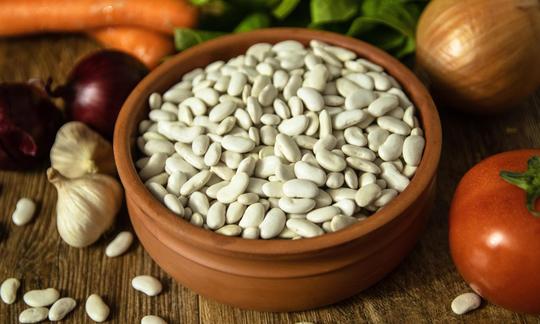


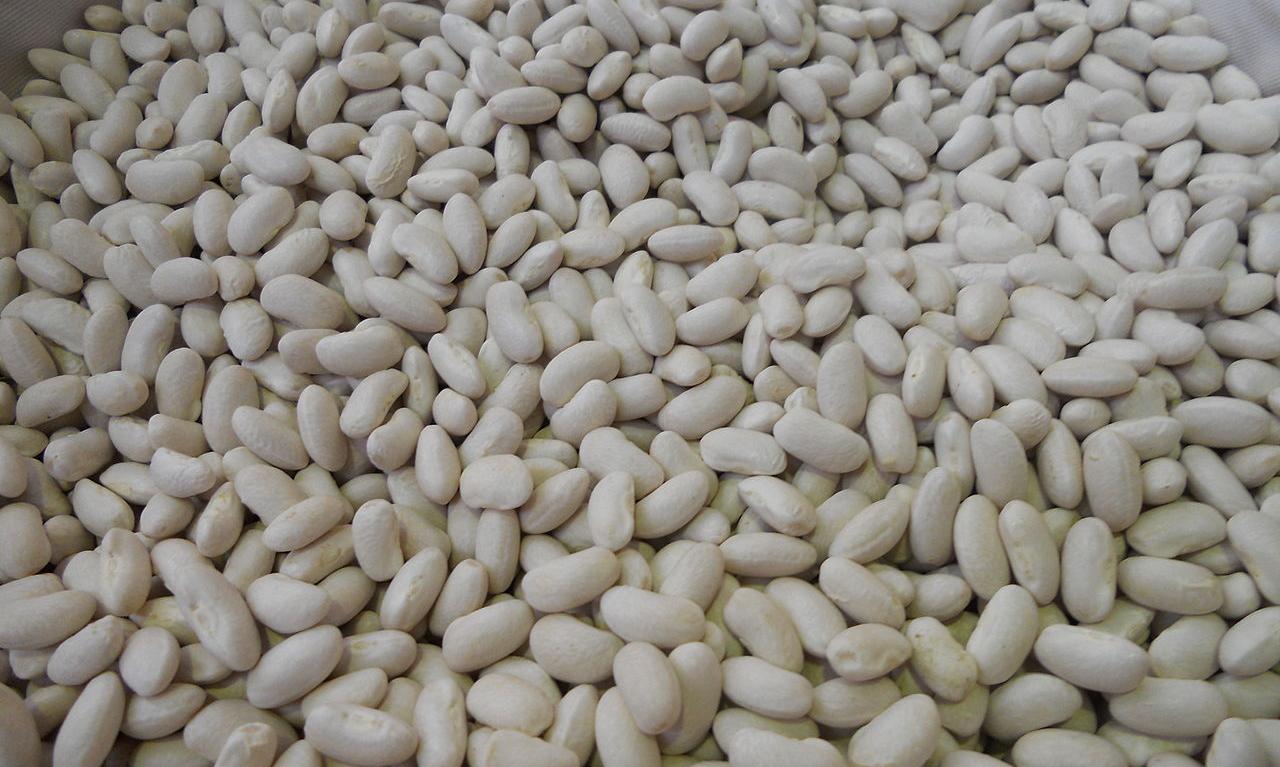
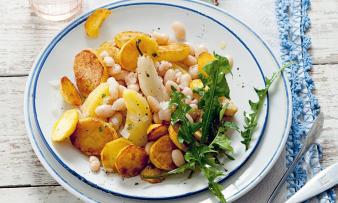
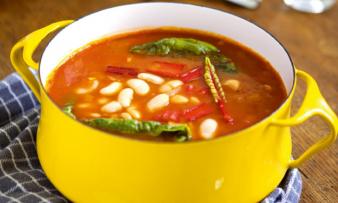
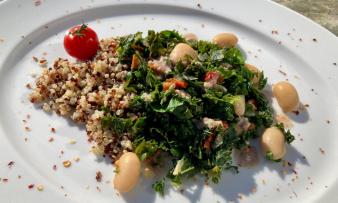


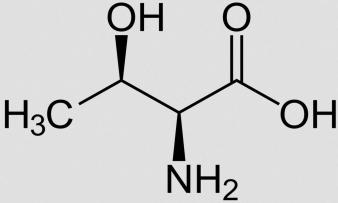


Comments